

European
Nuclear Society
e-news
Issue 27: February 2010
Winter appears reluctant to loosen its icy grip and for many of us life seems to be suspended in a temporary time warp. However, appearances can be deceiving. Among the many characteristics that typify the human condition is an instinctive almost genetically pre-programmed need to start again and innovate. It may be winter outside, but human endeavour is not regulated by the seasons. Underneath the layer of snow there is a hive of activity going on; a buzz of optimism and expectancy. We have left behind the “noughties” and entered the “teenies.” The first year of the new decade looks like being one marked by new departures and initiatives, by democratic consolidation and by significant political developments. 2010 promises to be a productive year on all fronts. And spring hasn’t kicked in yet!
From a political perspective it certainly is all change and regeneration as a new European Commission, a new R&D Commissioner and a recently-elected European Parliament have emerged into the light of a new expectant decade. But it’s not just about changing faces; among other things, 2010 should see the adoption of a new EU Directive on radioactive waste, the launching of the European Sustainable Nuclear Industrial Initiative (ESNII) within the framework of the Strategic Energy Technology Plan (SET-Plan) and the publication of the SNETP’s Deployment Strategy document. These could prove to be significant developments for the European nuclear research community. In Europe’s corridors of power, as well as in industry circles and the media, there is recurrent talk of extending the operational duration of nuclear plants, of ambitious new build plans and of nuclear energy’s contribution to the global low-carbon economy. Gradually more countries are announcing plans for storing the radioactive waste they produce – proving that technical solutions for storing it not only exist, but are increasingly being put into practice. As fence-sitters return to ground level, and doubters doubt their doubts, public opinion continues to evolve favourably.
From a research perspective the growing endorsement by Europe’s power broker’s of the need to invest more in nuclear as a pillar of the EU’s low-carbon economy is a welcome development. It is also a prerequisite. But this current momentum needs to be maintained and inspiring rhetoric turned into deeds. Research cannot prosper in a power vacuum. Politicians come and go, as do EU Framework Programmes too. But the classic polemic about where the money most needs to be spent and whether less should go to fusion and more to fission remains….as persistent and unresolved as ever. Generally speaking, however, the early signs in 2010 are positive. The announcement of new collaborative ventures aimed at pooling resources and expertise and exploiting synergies have got the new decade off to a positive start. One example of this is the new collaborative venture signed by SCK-CEN and Belgoprocess in Belgium. This strategic agreement encompasses various areas of research into nuclear technologies, with a main focus on feasibility studies, technology transfer and training.
As far as ENS is concerned, the momentum of renewal is very real too: Vladimir Slugen was recently elected as new President of the Society, taking over from David Bonser. ENS NEWS N° 27 includes his first Word from the President contribution.
2010 will also see feverish activity in the international conference scene. Flagship ENS conferences, like PIME (Budapest, 14 – 16 February) and RRFM (Marrakech, 21 – 25 March) will be joined on the agenda by the biannual ENC (Barcelona, 30 May – 2 June).
From an industry perspective FORATOM will celebrate its fiftieth birthday this year - half a century of serving the European nuclear industry by acting as its voice and advocate in the European institutional arena. For FORATOM the political agenda promises to make 2010 a very busy year. In fact, it might even be a watershed year. But first, a word of caution….as a wise man once said (well, actually it was Linus from the cartoon series Peanuts): “There’s no heavier burden than a great potential.” Hopefully the expectations of a new nuclear decade will be matched by real progress for the research community. Hopefully the promise of success will not prove to be too heavy a burden. Only time will tell.
The first ENS NEWS of the new decade kicks off with the first Word from the President penned by our new President: Vladimir Slugen outlines his priorities and vision for the future of the Society.
Andrew Teller then attempts to “exorcise fears and rectify misunderstandings” that the public has when it comes to radiation. A thorough expert analysis by the High Scientific Council of ENS on the crucial subject of nuclear education, training and knowledge management in Europe then completes the ENS NEWS section.
The events section of N° 27 highlights the busy ENS conference agenda in 21010, which will see three major events, PIME 2010 (Budapest, 14 – 16 February), RRFM 2010 (Marrakech, 21 – 25 March) and ENS 2010 (Barcelona, 30 May – 2 June.
We have a packed Members Societies and Corporate Members section in store for you in the 2010 winter edition. First up is a report from the Bulgarian Nuclear Society on the Nuclear Power for the People conference that took place at Veliko Turnovo from 11 – 14 November 2009. That is followed by a fascinating article on the true climate change credentials of nuclear energy that was recently written by SFEN and published in the French daily newspaper, Libération.
Our friends from the Nuclear Industry Association (NIA) in the UK then give readers a detailed overview of the state-of-the-art National Nuclear Laboratory facilities at Sellafield. Slovenia’s decision to locate its first low and intermediate-level waste storage site at Vrbina – close to the country’s only NPP at Krško – has been making the headlines and ENS NEWS next gives readers an insight into the selection process, the significance of the decision and the stakeholder consultation process that was a feature of it.
Next up is a round up of news from the Spanish and Finnish nuclear societies: the former includes a focus on three issues of the Spanish Nuclear Society’s magazine, Nuclear España and the latter highlights, among other things, a fascinating fact-finding trip that the Finnish Nuclear Society made to South Korea.
The positive evaluation that the OECD/NEA has given to the MYHRRA project is one of two detailed reports involving SCK-CEN – the other concerns the cooperation agreement that it recently signed with Belgoprocess.
Finally, readers can learn about the Visaginas NPP construction project that holds the key to Lithuania’s future nuclear programme.
The YGN section of ENS NEWS N° 27 includes three reports: one on the 2009 ETRAP conference (Lisbon, 8 – 12 November, 2009), which once again put the spotlight on the importance of education and training for the future of the nuclear sector; a second one on the COP 15 global climate change conference and an event they organised with the help of WNA/FORATOM and the OECD/NEA and one from the Spanish Young Generation’s (JJNN) fact-finding visit to Chernobyl.
The ENS World News section provides the usual combination of important news reports from NucNet and additional information about upcoming ENS conferences.
Enjoy your latest edition of ENS NEWS!
|
|
http://www.euronuclear.org/e-news/e-news-27/presidents-contribution.htm


 |
For more than 30 years ENS has been recognised as an international organisation that offers valuable expertise and considerable competence in the field of nuclear science and technology. With the help of all my colleagues and friends at ENS I will do my utmost to build upon past achievements, to carry on the good work of our previous President, David Bonser, and to promote the peaceful applications of nuclear energy and radiation technologies. |
|---|
As I begin my term as President I would like to stress what I see as the fundamental objectives and guiding principles of ENS. They are as follows:
To enhance and highlight the reputation of ENS as a byword for expertise and professionalism
To promote and emphasise the proven scientific and academic excellence of ENS
To strengthen the role and visibility of ENS as an effective source and manager of knowledge relating nuclear science and technology
To enhance the reputation of ENS as a trusted and effective communicator with the general public
To offer the nuclear industry an independent and credible platform for information exchange, technical advice and competence
ENS should, in my view, be acknowledged by the public as being synonymous with expertise and professionalism when it comes to the peaceful applications of nuclear energy and ionizing irradiation technologies. At the same time, the nuclear power industry should maintain its pivotal position at the heart of our activities. Our members should be sought out as competent and trustworthy evaluators or advisors.
Bearing in mind the current nuclear renaissance, ENS should be more active and visible also at the university level. It should try to offer university graduates a “new dimension” by impressing upon them that the nuclear sector offers excellent career prospects and that in ENS they can consult an organisation that is able provide answers to professional questions (through the meetings, workshops and seminars on national or international issues that it organises at both a formal and informal level). Furthermore, by networking within ENS they can experience for themselves the strong sense of community spirit and pride in doing the job that typifies it.
The European Nuclear Society was created primarily to support the national nuclear societies and its collective international membership. Today, as it has always been, it is necessary to listen to and meet their needs.
I am proud to have the opportunity to serve the Society and am happy to know that I can count upon your support and advice. I am confident that thanks to our common efforts ENS will become an even stronger and more respected organisation than it already is. That is what will be needed in the new “nuclear age.” I pledge to do everything I can to help make this a reality.
Vladimir Slugen
President of ENS
http://www.euronuclear.org/e-news/e-news-27/listening.htm


Mark O’Donovan, the ENS NEWS Editor-in-Chief, sent me the following quotation from an eminent Oxford University physicist, Professor Allison Wade:
“Radiation is about a thousand times less hazardous than is suggested by current safety standards. For many this will come as a surprise… The case for a complete change in attitude towards radiation safety is unrelated to the effects of climate change. But the realisation that radiation and nuclear energy are much safer than is usually supposed is of extreme importance to the current discussion of alternatives to fossil fuels and their relative costs. I have no links with the nuclear industry I just want to see the truth out there. So many people have been under a misapprehension for so long.”
His idea was to find out whether I could exorcise some common fears and rectify common misunderstandings regarding this subject.
The bad news is that I’m probably going to disappoint him: I can’t. The good news is that I think I can explain why I – or anybody else for that matter – can’t. Dispelling misconceptions about subjects linked to wider agendas always proves to be overambitious. And this is indeed the case of radiation, which has since long ended up as a pawn on the chessboard of nuclear controversy. Having an objective, dispassionate discussion on the impact of nuclear radiation has probably always been an out-of-reach dream. To be fair, both those for and against nuclear energy have a vested interest the matter. Being for/against it will make you less/more receptive to suggestions that radiation is dangerous even in the smallest quantities. The two issues are irremediably entangled: any evolution in one’s thinking on one score has the potential to affect the other, which increases one’s resistance to new pieces of information. As if this was not bad enough, one’s critical skills get all too easily blunted when an argument is recognised as reinforcing one’s current position. I would like to provide two examples of this unfortunate tendency. Unsurprisingly, they will stem from anti-nuclear literature: being in favour of nuclear energy, my critical skills are better trained to spot the weaknesses in the reasoning of those who oppose it.
The first one comes from a 1976 book, still in the early days of the anti-nuclear movement (three years before the Three Mile Island accident!): Unacceptable Risk – The Nuclear Power Controversy, by McKinley C. Olson. In this book, the author reported on the work done by a Dr Edward E. Martell, who came up with a quite clever theory on the dangers posed by alpha radiation. Dr Martell concluded that smokers are particularly exposed to lung cancer because each time they light a cigarette they inhale alpha-emitting material. Alpha radiation can be stopped by the lightest obstacle (cigarette paper is an oft quoted example!). But when there is nothing to stop it, as would be the case in the lungs, it can wreak havoc in the surrounding cells. Why would cigarettes contain meaningful quantities of alpha-emitting material? According to Dr. Martell, this is because there are tiny hairs on the surface of tobacco leaves. These hairs have “sticky glandular heads on their tips that collect radioactive dust particles”. These dust particles come from the fertilizer used to treat the tobacco soil: the fertilizer has a large phosphate content which in turn contains “rich amounts of radium”. Dr Martell insisted that it was radioactivity that was the culprit: he commented that only asbestos workers who were also smokers had a high lung cancer rate and that non-smoking asbestos workers were no more prone to lung cancer than other non-smokers. The outcome of his investigation was that the danger posed by radioactivity had been seriously underestimated and that admissible doses resulting from nuclear activities had to be drastically reduced.
We cannot blame Dr Martell and McKinley C. Olson for not having known that asbestos does not need the assistance of smoking to cause cancers. But we can wonder why they overlooked another basic flaw in this theory: if this interpretation was correct, the mechanisms described should provoke cancer with near certainty. How is it then that so many smokers escape the illness? Today the cause of lung cancer in smokers is ascribed to the thousand or so toxic chemicals found in cigarettes. Has this change in the understanding of the causation of lung cancer lead to a reappraisal of the impact of radiation? Not for those who oppose nuclear energy. And this is where the second example comes in.
In 2003, a so-called European Committee on Radiation Risk (it’s got nothing to do with any EU institution) issued recommendations that contradicted the official position of the International Committee on Radiation Protection (ICRP). In the present case, the reasoning does not rest any more on the basics of radiation protection such as the bodily damage induced per radiation type and the duration of residence of radioactive material in various organs. The problem is stated in terms of DNA damage, cell replication and repair, etc. Nothing wrong again with this, but two other factors are worrying for the non-specialist trying to gauge the validity of the report. First, it is not a piece of pure scientific investigation. The document starts with a sizeable exposition of the authors’ political and ethical views. Without even dwelling on the fact that I for one find their views repulsive, I submit that starting a research paper by indicating one’s personal political and ethical objectives is not the best way to convince the reader of its scientific worth. The reality of findings must be supported by critical observations, not by moral preferences. Second, when confronted with discrepant information, the elements that are dismissed are systematically those that do not agree with the authors’ broader objectives: it is impossible to believe that this way of sorting the facts out could be justified in each instance. So through a totally different approach, the same outcome is achieved: radiation protection recommendations leading to permissible levels of radiation much lower than those quoted by the ICRP. The very opposite of what Professor Wade is advocating. Those who are convinced that the impact of low level radiation is vastly underestimated are holding on.
Such lasting opposition is facilitated by the fact that many pieces of information, some of which are contradictory, have to be reconciled. Depending on the weighting coefficients allocated to each of them, one conclusion or the opposite one will be reached. Declarations such as Professor Wade’s are most useful in tilting the scale in a scientific direction, but this will not convince those who do not like the consequences entailed.
http://www.euronuclear.org/e-news/e-news-27/hsc-statement.htm

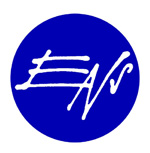
The situation in the nuclear education today is complex as it relates to nuclear technology for both peaceful and security applications. After more than 20 years period of depression in nuclear facility construction (significant mainly in Europe and USA), there is strong renewed interest in nuclear-generated electricity. Many factors have contributed to “nuclear renaissance” including concerns about possible climate changes due to carbon emissions.
The Nuclear Energy Agency (OECD/NEA) study in 2000, “Nuclear Education and Training….Cause for Concern” [1], highlighted the necessity for a renaissance in nuclear education and training and recommended the following:
We must act now
Strategic Role of Governments
The Challenges of revitalising nuclear education
Vigorous research and maintaining high quality training
Benefits of Collaboration and Sharing Best Practices
The world has responded. From the Americas to Europe to Asia networks have been established to respond to the necessity to maintain and perpetuate nuclear knowledge in order to provide a suitably qualified workforce for the future operation of nuclear power plants [2]. Nevertheless, the European Nuclear Energy Forum created in 2007 by European Commission identified the nuclear education as one of highest risks in nuclear industry. The nuclear renaissance depends on the increased number of engineers properly educated in wide spectrum of nuclear disciplines.
The European Nuclear Society (ENS) also responded by launching the NESTet conference (Budapest, May 2008 [3]) that has been designed to facilitate the exchange of information, collaboration and the sharing of best practices in nuclear education and training in engineering science and technology as well as knowledge management in this energy sector. The NESTet conference complements the American Nuclear Society (ANS) Conference on Nuclear Training and Education (CONTE) which was held in Florida in February 2007. The European Commission/EURATOM, the International Atomic Energy Agency (IAEA), the Nuclear Energy Agency (NEA) and the Joint Research Centre (JRC) have clearly recognised risks form missing nuclear knowledge, but conclusions and recommendations from conferences and discussion have to be implemented into the national education programs running at the universities or in trainings centres.
The quality in Education, Training and Knowledge Management (ETKM) is strongly influenced and supported by development of nuclear research, exploitation of experimental and training facilities, existence of proper education and training networks, software tools, distance and e-learning and a variety of knowledge management activities. Nuclear knowledge is required in many areas as: nuclear engineering, nuclear technology, nuclear medicine, radiological protection or waste management. The wide international collaboration in all mentioned areas is encouraged, but the basic knowledge has to be created on national level. New national and regional academic networks have been recently developed in the Americas, Asia and Europe to meet workforce requirements.
The projected global annual requirements for new nuclear engineers over the next 10 years will challenge existing academic and training institutions with respect to capacity and load factors on classrooms, laboratories and other facilities such as basic principles simulators. Additionally, the nuclear academic workforce may need to increase to meet the demand for educating/training the new industrial workforce and this will take time.
Within the European context many of the programmes will continue through private and public funding as well as private-public partnerships. The continued development of a common qualification approach, mutual recognition of institutions across Europe, increased mobility of staff and students and the creation of strategic partnerships will help to develop a well skilled and mobile workforce to support the nuclear energy renaissance.
Within the European context, the development of the infrastructure to address nuclear ETKM has to date been largely driven by the European Commission/DG RTD Energy/ Euratom and a comprehensive overview of the European actions to address nuclear related ETKM activities was given my Georges Van Goethem at NESTet 2008 [3]. Within the scope of an ENS Expert Analysis it is appropriate to review these activities.
The Euratom Treaty (Rome, 1957) clearly recognized the importance and necessity for training and research to promote the field of nuclear energy, as given in the excerpts given below.
Under "Provisions for the encouragement of progress in the field of nuclear energy" CHAPTER 1 / PROMOTION OF RESEARCH / Article 4
1. The Commission shall be responsible for promoting and facilitating nuclear research in the Member States and for complementing it by carrying out a Community research and training programme.
Under "Provisions for the initial application of this Treaty" / Article 215
1. An initial research and training programme, which is set out in Annex V to this Treaty and the cost of which shall not …exceed … units of account, shall be carried out within five years of the entry into force of this Treaty.
Some 50+ years on and these aspects of the treaty are as important in order to support the renaissance. However, a more integrated model has now developed as illustrated in Figure 1.

Figure 1: “Knowledge Triangle” (research & development) and "Energy Triangle" (demonstration & deployment) (G. Van Goethem [3])
The European Commission have been mindful of the integrated model illustrated above so that all key stakeholder requirements are addressed and Euratom’s E&T objectives therefore focused on the following aims:
MODULAR COURSES AND COMMON QUALIFICATION APPROACH (offer a coherent E&T framework and ensure top-quality for each module)
ONE MUTUAL RECOGNITION SYSTEM ACROSS THE EUROPEAN UNION (e.g. European Credit Transfer and accumulation System of ERASMUS /ECTS)
MOBILITY FOR TEACHERS AND STUDENTS ACROSS THE EU
prepare the "internal market" for free circulation of nuclear experts)
FEEDBACK FROM "STAKEHOLDERS", BOTH SCIENTIFIC AND FINANCIAL (involve the "future employers" in the process).
An early success from this Euratom initiative was the creation of the European Nuclear Education Network (ENEN) association as a legal entity under the French Law of 1901. Today the ENEN association is a well integrated mature pan European organization with over 40 members, as illustrated in Figure 2, delivering the objectives set out my Euratom and more details on ENEN can be found at Reference [4].
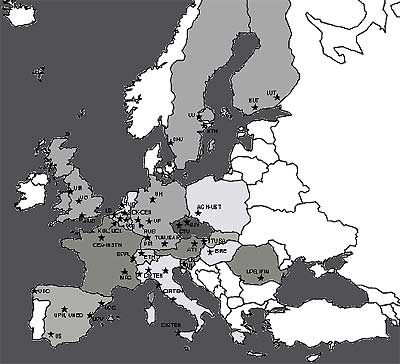
Figure 2: ENEN Association Members
In addition to ENEN, the European Network for Education and Training in Radiological Protection (ENETRAP) [5] has been developed and many EU member states have created networks of their own and a summary of these is given in Table 1. Other educational activities dealing with radioactive waste management, radioecology and radiobiology are also supported within the Euratom Framework programmes (CETRAD, EURAC, MSCRB etc) and again more details can be found in Reference [3]. As a result of these activities, many revitalised and new courses have been established, European Credit Transfer Schemes (ECTS) have been employed, student and staff mobility has been resourced and mutual recognition is apparent across the European Union. In many cases these activities have been funded by public bodies but greater emphasis is now needed on public-private partnerships in order to provide the capacity to meet the demands for the nuclear workforce for the future. New academics will also be required to meet the demands for the future and this requirement needs immediate action. Recent activity in this area has been the transfer of senior scientists and engineers from industry into academia.
Table 1: Nuclear Education Networks in Europe |
|
|
|
|
|
|
|
|
|
|
With reference to Figure 1, an important part of the knowledge integration is research and training. Within the European context there have been significant activities in these areas, examples of which are given in Table 2.
Table 2: Research/Training Programmes |
PERFECT10: resources are assigned for training in advanced numerical simulation tools for irradiation damage. The proposed numerical tools allow students to perform “virtual irradiations” on “virtual reactors”, with the aim to analyse the resulting evolution of mechanical properties and microstructure. |
SARNET11: an education and training programme is foreseen directed at young scientists. The aim is to consolidate European excellence in the long-term in the areas of experimental and numerical simulation as well as in level 2 probabilistic safety assessment methods and in mitigation techniques related to severe accident management. |
RAPHAEL12: a number of major industrial issues are discussed in connection with future industrial needs and energy policies (e.g. high temperature heat and electricity supply, natural resource preservation). Special attention is paid to education in innovative nuclear hydrogen production technologies and in communication. |
EUROTRANS13: there are 17 universities, represented by the ENEN Association. At least 5% of the budget is assigned to PhD students, with additional funding reserved for E&T (detailed course programme in www.enen-assoc.org). It is also worth mentioning the launch of a doctoral school on E&T by the ENEN association in this EUROTRANS project. |
|
ESDRED:14 ("Engineering Studies and Demonstration of Repository Designs"), the partners (waste management agencies and technological R&D organisations) organise training sessions of broad interest. One of their general aims is to fabricate and test prototypes of technologies for deep geological disposal of high level radioactive waste (such as spent fuel or vitrified waste), for backfilling and for sealing disposal cells or drifts. |
RISC-RAD:15 (“Radiosensitivity of Individuals and Susceptibility to Cancer induced by ionizing RADiations”), there are courses on “quantitative radiation risk modelling” and on “ethics in biological experiments”. |
EURANOS:16 (“EURopean Approach to Nuclear and radiOlogical emergency management and rehabilitation Strategies”), training is organised in connection with “real time on-line decision support (RODOS)” for emergency management and rehabilitation strategies. |
Some activities are embedded in large infrastructure programmes and a selection of those proposed for the Framework 7 programme are given in Table 3.
Table 3: Embedded Programmes Covering Research/Training |
1 - ACSEPT / Actinide reCycling by SEParation and Transmutation: The overall goal is to advance the European integration in the fields of separation techniques, and actinide chemistry. Strong links will be established with the direct or derived actions of the FP-6 Network of Excellence ACTINET. |
2 - GETMAT / Gen IV and Transmutation MATerials: The overall goal is to motivate a new generation of material scientists to study and deepen the open challenges in the materials science for nuclear applications. In addition workshops in collaboration with OECD/NEA and IAEA will be organized. |
3 - CARBOWASTE / Treatment and Disposal of Irradiated Graphite and Other Carbonaceous Waste: The overall goal is to develop the scientific competence and human capacity that will guarantee the availability of suitably qualified researchers, engineers and employees in this specific field of legacy waste management. |
4 - F-BRIDGE / Basic Research for Innovative Fuel Design for GEN IV: The overall goal is to share the modelling and experimental methodologies in fuel materials sciences that will be developed during the project. The project will organise two summer schools demonstrating to young scientists and engineers how basic research in material science can contribute to the understanding of fuel behaviour under irradiation and to the selection and development of advanced fuels. |
5 - SEDENTEXCT - Safety and Efficacy of a New and Emerging Dental X-ray Modality: The aim is the acquisition of key information for sound & scientifically based clinical use of Cone Beam Computed Tomography (CBCT) & to use them to develop guidelines dealing with justification, optimisation & referral criteria and to conduct dissemination and training for users of CBCT. |
6 - MADEIRA - Minimizing Activity and Dose with Enhanced Image quality by Radiopharmaceutical Administration: The goal is to improve 3D nuclear medicine and molecular imaging technologies and with this the quality of the diagnostic information obtained & to reduce the amount of radioactive material to be administered. |
7 - ORAMED - Optimization of Radiation Protection of Medical Staff: The goal is to improve standards of protection for medical staff for procedures resulting in potentially high exposures and to develop methodologies for better assessing and reducing exposures to medical staff in interventional radiology (IR). |
In addition, under Framework 7, ENEN-III has been funded to develop Euratom Fission Training Schemes (EFTS). Members of the ENEN Association will work on a selected number of nuclear sector skills profiles, develop training profiles and establish pilot schemes whereby the concept of a Passport for Continuous Professional Development may be created to meet industry requirements.
A review of the European context for ETKM would not be complete without considering the framework in which it will sit for the future. This framework exists at the higher level within European Strategic Energy Technology Plan (SET plan)and specifically with respect to the nuclear option, in the Sustainable Nuclear Energy Technology Platform (SNE-TP 18) with a detailed Strategic Research Agenda (SRA) addressing Generation II, III and IV reactor systems. The SRA will supported by cross-cutting activities in the deployment strategy and education, training and knowledge management areas. In parallel other initiatives that will influence the context for ETKM are the European Nuclear Energy Forum (ENEF 19) and the High Level Group (HLG). Amongst other activities, ENEF will consider on-line sources for nuclear education, possibly a schools curriculum for basic nuclear technology understanding and the concept for creating a European nuclear observatory. The HLG is composed primarily of senior officials from national nuclear regulatory or nuclear safety authorities. It will be important for ETKM providers to address future developments by this group in order to support a common integrated approach to nuclear safety culture.
Endorsement of ETKM activities within the European Union is of the utmost importance and this has been given by the Council of the European Union in their Conclusions on the Need for Skills in the Nuclear Field [6]. Of particular note is the importance the Council places on an integrated nuclear skills framework within Europe as given in the quote from [6] below.
In particular, THE COUNCIL INSISTS that the appropriate conditions must be created for mutual recognition of nuclear professional qualifications throughout the European Union; ENCOURAGES the Member States and the Commission to establish a "review of professional qualifications and skills" in the nuclear field for the European Union, which would give an overall picture of the currentsituation and enable appropriate solutions to be identified and implemented. Such a review could pave the way for drawing up a pan-European chart of skills and knowledge relating tooccupations in the nuclear field; acceptance of this could lead to the production of a European handbook of skills, experience and professional qualifications, which would facilitate the mobility of employees within the EU.
Other influential organizations that are contributing significantly to the ETKM area are the Nuclear Energy Agency (OECD/NEA) and Joint Research Centre (JRC) and most importantly, the International Atomic Energy Agency (IAEA). A quote from the IAEA is therefore appropriate.
“As the nuclear workforce ages and retires, and support decreases for university programmes in nuclear science and engineering, knowledge management is becoming critical to ensuring safety and security, encouraging innovation, and making certain that the benefits of nuclear energy - related to human health, food and agriculture, water management, electricity supply, and a host of other applications - remain available for future generations.”
Mr. M. El Baradei, Director General of the IAEA, 2000
The Present Position
Within nine years of the OECD/NEA report, Nuclear Education and Training…… cause for concern, an enormous amount of activity has been undertaken in the area of ETKM as summerised above. It may seem as though nuclear ETKM is in its renaissance period but we must not be complacent. Indications are that the “cliff edge” of nuclear workforce retirements is drawing ever closer and when this impact is taken together with the growth needed in the workforce to meet the global demand for nuclear power, the challenges facing the ETKM sector remain, but at least we are heading in the right direction. While this paper has focused on the European context, there are international ETKM developments under progress by Euratom and the IAEA in all global sectors.
References
[1] Nuclear Education and Training….Cause for Concern, OECD study, 2000
[2] Nuclear Human´s Element, American Nuclear Society Report, 2007
[3] Proceedings from ENS conference NESTet, 2008
[4] ENEN Association (www.enen-assoc.org)
[5] ENETRAP (www.sckcen.be/enetrap/)
[6] Skills in the Nuclear Field, EU Council, 2 December 2008, st 15406.
15see www.riscrad.org/
19 ec.europa.eu/energy/nuclear/forum/index_en.htm
http://www.euronuclear.org/e-news/e-news-27/pime2010.htm


ENS
PIME 2010, which will take place in
The programme for PIME 2010 is now available at: www.pime2010.org
Here is a flavour of what you can expect in Budapest
Day 1 will feature a number of keynote speeches, plenary sessions, case studies and panel discussions dedicated to exploring the core question of how communicators can connect even more effectively with the public and so help replace common myths and misconceptions about nuclear energy with the facts.
Day 2 PIME the spotlight switches to discussions and interactive workshops focusing on some of the key issues facing nuclear communicators, notably how internal communications can provide a platform for improved external communications and the perennially important subject of communicating in a time of crisis.
Day 3 will give delegates the opportunity to take part in a range of technical tours.
PIME is a well-established fixture on the international conference agenda and offers a great opportunity for communicators to discuss what matters most in their job with the people whose opinions they value most.
Make sure that you are part of the PIME experience and……
For
further information about PIME 2010 please contact:
www.pime2010.org
pime2010@euronuclear.org
http://www.euronuclear.org/e-news/e-news-27/rrfm2010.htm


Top-expertise and knowledge from first-class scientists and industry representatives will inspire and inform the auditory and open up new perspectives in research reactor topics. Colourful and diversified evening events at traditional places of Marrakech and a post-conference visit to the TRIGA Mark II reactor at the Maamora Nuclear Research Centre offer the perfect balance to the ambitious technical sessions.
Delegates at RRFM 2010 will discuss:
International Programmes
All key areas of the nuclear fuel cycle of Research Reactors
Innovative methods in research reactor analysis and design
Utilization of Research Reactors
Research Reactor Support for Innovative Nuclear Power Reactors and Fuel Cycles
New Research Reactor Projects
The 2010 TRIGA User Meeting will be as an embedded meeting within RRFM 2010.
Programme is available now on:
We are looking
forward to meet you in Marrakech !
Conference
Secretariat:
European Nuclear Society
65 Rue Belliard
1040
Tel. +32 2 505 30 54 |
http://www.euronuclear.org/e-news/e-news-27/enc2010.htm


ENS would like to thank all its members for sending contributions to ENC 2010. We received a great number of high quality abstracts which allowed the ENC Programme Committee to build a very interesting conference programme. This programme will be available from Wednesday 3 February on the ENS website and the ENC 2010 conference website.
We also would like to inform you that the ENC 2010 Industry Exhibition has been sold out and that we will extend the exhibition space by 1000 sqm to over 3000 sqm. If your organisation considers exhibiting at ENC 2010, please contact the ENS Secretariat. As always, you will receive 10% reduction and priority choice on available space.
Conference
Secretariat:
Tel. +32 2 505
30 54 -
Fax +32 2 502 39 02
enc2010@euronuclear.org
http://www.euronuclear.org/e-news/e-news-27/Bulgarian-Nuclear-Society.htm

 BULGARIAN NUCLEAR SOCIETY
BULGARIAN NUCLEAR SOCIETYBulgarian Nuclear Society held its annual conference entitled: Nuclear power for people at Veliko Turnovo, Bulgaria, from 11 - 14 November 2009.
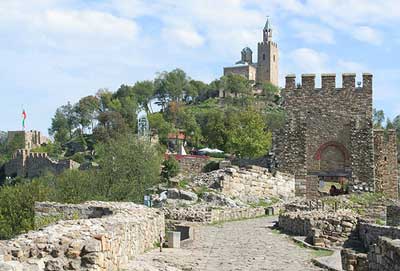
Veliko Turnovo is a city in the north-central region of Bulgaria and the administrative centre of the Veliko Turnovo Province. Often referred to as the "City of the Tsars", Veliko Turnovo is located on the Yantra River and is famous as the historical capital of the Second Bulgarian Empire. It attracts many tourists with its unique architecture. The old city is situated on three hills, Tsarevets, Trapezitsa and Sveta Gora, rising up from amidst the meanders of the Yantra. Tsarevets housed the palaces of the Bulgarian Emperors and the Patriarchate, as well as a number of administrative and residential edifices surrounded by thick walls. In the Middle Ages it was one of Europe’s main centres of culture and gave its name to the Turnovo Artistic School of architecture, painting and literature.
Reports and discussions during the conference focused on the applications of nuclear science for the public’s benefit, the key role of the human factor in nuclear medicine and training specialists for the nuclear industry.
The conference was attended by prominent Bulgarian and foreign scientists, as well as experts and young professionals in various fields, e.g. physicists; engineers; chemists, physicians from the Bulgarian Academy of Sciences; the Nuclear Regulatory Agency ; NPP Kozloduy; the universities of Sofia, Plovdiv and Varna; the National Center for Radiobiology; the Medical University of Sofia; companies in the field of nuclear energy; nuclear research centers from Belgium, France, Russia, Japan and India; the European Commission; the European Joint Research Center and the European Nuclear Society.
The list of guest speakers included: Akira Matsumura (University of Tsukuba), Andreiy Gagarinski (KI Russia), Ion-Christian Kiricuta (Institute of Radiation Oncology), George Van Goethem (EC), Haileyesus Tsige-Tamirat (JRC), Gerard Cognet and Bernard Bonin (CEA), Marion Brünglinghaus (ENS), Ioana Patrascu (Institute for Physics and NE), Barun Chatterjee (BARC), Borislav Dimitrov (IRSN), Boyka Nenkova (Risk Engineering), Neli Yankova (BNRA), Tihomir Apostolov (INRNE).
There was also a young authors' competition and prizes were awarded to the winners as follows:
First prize - G. Gerganov,fromSofia University "St. Kliment Ohridski", Bulgaria, for the paper entitled : Recent developments in the "EGS PET" Monte Carlopet simulation code
Second prize- Svetlin Philipov, of Risk Engineering, Bulgaria, for the study called: Benchmark analyses and special features of integral codes and alternatives applicable in an NPP.
Third prize - Yordan Madzhunkov, from Sofia University "St. Kliment Ohridski", Bulgaria, for the report entitled: New image reconstruction related developments in the"EGS PET" MONTE CARLO PET simulation code.
There was also a best poster award, which went to the young author Alexander Yordanov, of EnproConsult, Bulgaria, for the poster entitled: Evaluation of uncertainties in best estimate accident analysis :Preparation of input deck for psb vver and steady state qualification.
The safe operation of NPPs and the successful construction of new nuclear plants are imperative to ensure a competent, highly-qualified and motivated staff. We have considerable expertise in the nuclear field, have mastered the best international practices and have valuable experience to help develop well-trained specialists with good theoretical knowledge and practical skills.
This was a very interesting conference. A number of relevant issues were also raised from a scientific management point of view.
The Bulgarian Nuclear Society expresses its committed to preserving and ensuring the necessary availability of human resources for nuclear energy today and in the future.
Ms. Boryana Atanasova, M.Sc.
Bulgarian Nuclear Society
Executive Secretary
Phone: (+359 2) 979 55 83
Cell:-(+359 87) 7 382 384
Fax:-(+359 2) 975 3619
E-mail: batanasova@inrne.bas.bg
http://www.euronuclear.org/e-news/e-news-27/nuclear-versus-co2.htm

The following article appeared in the 14 December 2009 edition of the French daily Libération. It was written by Francis Sorin, Director of Information at SFEN, and translated into English by Mark O’Donovan.
Energy experts and politicians used to question whether nuclear should be included in the fight against global warming. Well, as witnessed by the recent adoption - by a large majority -of a European Parliament Resolution that emphasises how “the transition to a global low-carbon economy has made nuclear energy an important player in the medium term energy mix,” they don’t need to any more.
Indeed, politicians and decision-makers in Europe, Asia and the US have recognised that the development of nuclear energy can improve our chances of avoiding a climatic event that would have disastrous consequences for the planet. But what are the arguments to support this thesis?
In order to combat climate change it is imperative that everyone, from the most committed productivist to the most ardent anti-productivist, agree upon one fundamental precept - that global emissions of CO2 must be reduced and, consequently, our dependence upon fossil fuels. Within this context nuclear energy has more impressive credentials than any other energy source when it comes to providing an effective and suitable replacement for fossil fuels. Nuclear energy is currently the only immediately available alternative energy source that can deliver “on demand” massive supplies of electricity without emitting any CO2. It is this significant ecological characteristic that to a large extent explains the global nuclear renaissance. What’s more, not just politicians but also leaders of flagship environmental organisations like Greenpeace and Friends of the Earth now concede that lifting any ban on nuclear energy would be consistent with the objective of fighting climate change.
In simple terms it has now become clear that nuclear can go a long way towards helping achieve the global CO2 reduction targets discussed at the Copenhagen Summit. Research carried out by specialised energy organisations has endorsed, in spectacular fashion, the conclusion that climate change is most effectively controlled in those scenarios where nuclear energy plays a determining role.
Today, around 30 billion tonnes of CO2 are emitted every year. This total has to be reduced by 50% by around 2030. If nuclear energy were sufficiently developed between now and 2030 – for example by doubling its current capacity in order to progressively replace decommissioned coal-fired power plants in industrialised countries – it would save 5 billion tonnes of CO2 emissions per year. A potential emissions saving of this magnitude, while clearly not the only objective, does nevertheless represent a significant asset when it comes to mitigating the greenhouse effect and preventing it from spiralling out of control.
If you believe the vast majority of climatologists today the threat of such an uncontrollable event occurring is very real. On 23 November 2009, Hervé Le Treut, one of France‘s most respected climatologists, declared: “As far as CO2 emissions are concerned, we have already gone beyond the worst-case scenario.” In other words, all the means currently at our disposal must be urgently exploited to reduce CO2 emissions. A combination of energy efficiency measures and use of renewable energy sources, which some people advocate as the solution to all our woes, simply cannot alone guarantee that that objective will be achieved. To get closer to achieving it the extra contribution of nuclear energy is indispensable. To ignore this energy source or to deliberately exclude it would be a highly irresponsible act tantamount to “non-assistance” of our endangered planet. In the climate change challenge that we face every tonne of CO2 emissions saved is important; every billion tonnes avoided is a vital contribution to the cause. The operational start-up of every new non-carbon energy production facility – whether based on exploiting renewables or nuclear energy – is a step in the right direction.
Logically, therefore, nuclear energy should be recognised during the Copenhagen Summit as a useful energy source for preserving the climate. Furthermore, it should also be “officially” included among a range of electricity producing technologies aimed at replacing fossil fuels and generating electricity at a time when global demand could double by 2050.
Francis Sorin, SFEN
http://www.euronuclear.org/e-news/e-news-27/national-nuclear-laboratory.htm

The UK's National Nuclear Laboratory (NNL) offers an unrivalled breadth of technical products and services to our customers across the whole nuclear industry. Covering the complete nuclear fuel cycle from fuel manufacture and power generation, through to reprocessing, waste treatment and disposal and including defence, new nuclear build and Homeland Security, NNL provides these services supported by an impressive range of links with international research organisations, academia and other national laboratories.
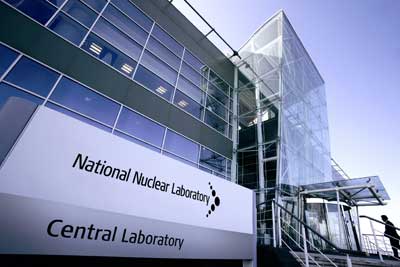
In supporting the national interest, NNL offers commercial technologies for customers and trusted technical advice to Government. Our team of highly skilled employees specialise in providing tailored solutions with the right balance of innovation for successful project and programme delivery.
NNL currently has 800 highly qualified staff with over 50% having 1st degrees, and over 20% having PhD’s. We are passionate about what we do and employ very high standards of safety and quality; NNL is ISO9001, ISO14001 and ISO27001 accredited. Safety excellence, commercial astuteness and technical intelligence are the key drives for our business.
NNL offers the following products and technical services across the whole range of industry sectors:
|
 |
The products and technical services are offered at the following locations:
Workington
NNL has consolidated its in-active test rig development activities in this new facility.
Sellafield
Facilities include high active alpha, beta & gamma cells, plutonium and MOX facilities, active/non active labs, full scale test facilities and a supporting infrastructure.
Windscale
Large flexible shielded facility capable of accepting a wide range of active materials, and equipped for all types of non-destructive and destructive examination.
Preston
Houses active laboratories capable of handling uranic materials from a laboratory to a production scale. It also contains engineering facilities for large scale testing.
Offices at Risley, Stonehouse and Harwell
NNL operates offices at these locations, in support of UK and International customers, UK Reactor operators and regulators and for Materials Science and Chemistry consultancy.
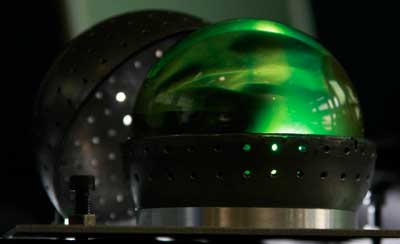
A series of 4 signature research areas have been identified as being central to the National Nuclear Laboratory mission. These areas encompass activities which are of strategic significance to the UK and worldwide nuclear industry. NNL currently carries out work for customers within these areas. The objective in each area is for the NNL to play an expanded and/or a more strategic role in carrying out research. The research areas are:
Spent Fuel and Nuclear Materials
Focuses on supporting ongoing operations, disposition of spent fuel, civil plutonium and civil uranium.
Waste Processing, Storage and Disposal
All aspects of waste immobilisation and processing aimed at producing wasteforms suitable for interim storage and disposal.
Reactors
This area is defined to include all of the research carried out in support of reactors from the design of the fuel or reactor through to the irradiated fuel.
Legacy Waste and Decommissioning
This area covers all NNL research associated with the management of the post operational legacy of nuclear operations through to their end point, covering the associated legacy of inventory, equipment, plant and site.
Keith Miller
Head of Marketing
National Nuclear Laboratory
For more information about the National Nuclear Laboratory in the UK you can contact Keith Miller at the following email address: keith.x.miller@nnl.co.uk or consult the NNL website at: www.nnl.co.uk
http://www.euronuclear.org/e-news/e-news-27/slovenia.htm


The outline design of the repository has already been finalised and the construction will be carried out in phases. The infrastructural and administrative sections will be the first on the list, followed by the technological part and, finally, the disposal area. Two silos will have the capacity to accept as much as 9.400 m3 of low- and intermediate-level radioactive waste, which comprises half of the radioactive waste generated by the nuclear power plant in Krško during its operation and decommissioning. The site will also be used for storage of all the institutional waste generated in Slovenia. In the event of an expansion of Slovenia’s nuclear programme or an agreement between Slovenia and Croatia (who jointly own a 50% share in the Krško NPP) about disposing of the total amount of the waste, the capacity of the site can be increased.
After an earlier failure in early 1990s, Slovenia started up the new site selection procedure in 2004. The Ionizing Radiation Protection and Nuclear Safety Act stipulated that the location must be selected by 2008, whereas the repository must start operating on a regular basis by the end of 2013.
This time the so-called mixed mode site selection process was applied, which not only observes technical norms but also makes social acceptability a key standard. In order to achieve social acceptability for a repository the mixed mode approach includes voluntary involvement and the co-operation of local communities in the process and a high level of participation of the local public in the decision-making process from the very beginning, in accordance with the provisions of the Aarhus Convention, and financial incentives.
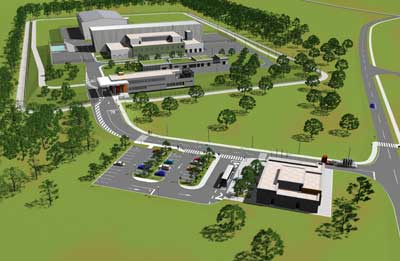
After the withdrawal or elimination of less appropriate sites, the location selection procedure was carried out from 2006 on two potential locations: the first situated in the municipality of Krško, and the other in the municipality of Brežice. Both locations are close to the nuclear power plant - the distance between them is about 1.5 km.
The procedure for the municipality of Brežice location practically came to a standstill in 2008 owing to a negative assessment of the site by the Department of Water due to its position in a flood zone. The procedure for the location in the municipality of Krško continued, albeit at a slower pace than envisaged by the law. The crucial step was made when the Municipality Council of Krško granted consent to the proposal of the national spatial plan for the repository on 6 July 2009 and thus made the final decision on behalf of the local community to allow the construction of the site in the local area. The procedure, which had lasted for 5 years, was successfully concluded with the passing of the regulation by the government.
In addition to the local partnership that ensured that the local public could take part in the decision-making process on equal terms, increased financial incentives also contributed to the social acceptability of the repository. A new regulation, passed in October 2009, not only doubled the original compensation amount of 2,568 million EUR per year, but also expanded the area where the local communities are entitled to the compensation, which is allocated in accordance with special criteria.
http://www.euronuclear.org/e-news/e-news-27/SNE-news.htm

 |
SNE News Update |
|---|
The Spanish government has decided to launch a period for the presentation of candidate locations wishing to host Spain’s Centralised Temporary Storage facility.
The Centralised Temporary Storage facility is a facility designed to house spent fuel from nuclear power plants and the high-level waste produced in Spain (total material to be stored 12,816 m3) at a single location. The facility does not generate energy, nor does it produce any pollution.
The facility will be built above ground and will house these materials under dry conditions for a period of 60 years in a system of modular spaces. The processes required for the interim management of all the high-level radioactive waste will be centralised at this facility.
For more information about this visit:
www.enresa.es/actividades_y_proyectos
Three new issues of Nuclear España were published during the last quarter, entitled: Issue 300: Directory 2009, Legislation and Regulatory Bodies and The 35th Annual Meeting. They include articles about each edition’s front page topic, as well as interviews of important personalities and news about the nuclear sector. The October edition Issue 300: Directory 2009 included interviews with the first ever and current Presidents of the Publications Commission of SNE, Rogelio del Haro and José López respectively. There is also an article about the history of Nuclear España Magazine.
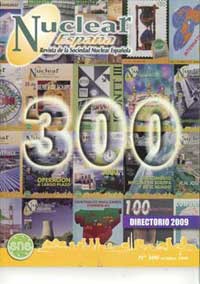
The Nuclear España Best Article Prize was awarded this year to a paper entitled Desarrollo normativo y nuevas prácticas reguladoras del CSN (Development of regulations and new regulatory practices at CSN), written by Isabel Mellado, from CSN. The runner-up prize was awarded to the paper entitled: La operación del sistema eléctrico español. Contribución de la generación nuclear (The operation of the Spanish electric system: the contribution of nuclear generation), written by Miguel de la Torre and Miguel R Duvison, from REE.
The Publications Commission also awarded, as was the case in previous years, an Honorific Mention to the magazine for its “distinguished technical quality and presentation.” This award was attributed to the monographic edition called CN Cofrentes.
The Spanish Nuclear Society (SNE) will hold its 36th Annual Meeting from 9 - 8 October 2010, in Santiago de Compostela. This annual coming together of the industry, companies and high representatives of the national and international nuclear and electric energy sector also provides an interesting excuse to get to know and enjoy the culture, landscape or gastronomy of the different Spanish regions. On this occasion the chosen city is Santiago de Compostela, where the delegates (around 500 are expected) and their companions, who together always total more than 200, will attend to the special celebrations held in the city on account of the Compostela Holy Year.
The Spanish nuclear power plants’ representatives will gather at the Winter Annual Session: Experiences and Perspectives; nuclear power plants in 2009 meeting. It will take place on 2 March 2010 at the Escuela Técnica Superior de Ingenieros Industriales of the Universidad Politécnica de Madrid (Industrial Engineering School). On the agenda will be an analysis of developments in the nuclear energy scenario over the past year.
The fifteenth edition of the Nuclear MaxiMarathon will be held in Spain from 18 - 24 of September 2010. The marathon route will take the runners from Garoña NPP to Madrid, via Burgos.
When the marathon is finished the participants will deliver to the Industry Ministry a manifesto protesting against the government’s decision to close the Garoña NPP in 2013 - a decision that has not taken into account the report submitted by the Spanish Nuclear Safety Council, which recommended that the Garoña plant could continue operating for ten more years beyond its original 40-years lifetime until 2019, as requested by the operator, Nuclenor.
It is expected that around 400 runners from 25 countries will take part. More information and a registration form to take part in the marathon can be found at:
www.wonuc.org/atomsport/marathon/presentation.htm
http://www.euronuclear.org/e-news/e-news-27/ATS.htm

The main annual event of the Finnish Nuclear Society (ATS), its autumn-seminar, took place on 5 November 2009 at the Palace Hotel Linna, in Helsinki. The main topic of the seminar was The Nuclear energy situation in Europe. The principal guest speakers were Sami Tulonen, Institutional Affairs Director at FORATOM, and E.ON Senior Vice President, Dr. Michael Micklinghoff. The seminar was attended by 139 members of the society.
The presentations given during the seminar are available in the archives of ATS on its website at: www.ats-fns.fi/info/arkisto.html.
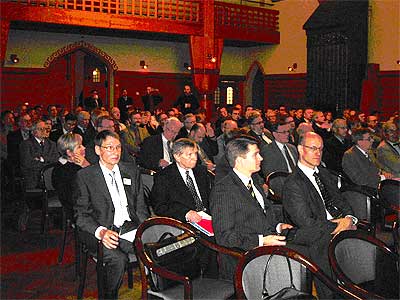
A total of 139 members of ATS participated the traditional autumn-seminar in Palace Hotel Linna in Helsinki.
The annual excursion of the Finnish Nuclear Society was to South-Korea and took place in 6 – 17 November 2009. A total of 16 members of ATS visited a wide range of industrial and research facilities and power plants both in operation and under construction. ATS also met the Korean Nuclear Society. ATS wishes to thank David Lee from KHNP and other hosts of the excursion for the excellent arrangements that were made and for the warm welcome given to the ATS group.
More information about the excursion is available from N° 4/2009 of the ATS magazine, Ydintekniikka.
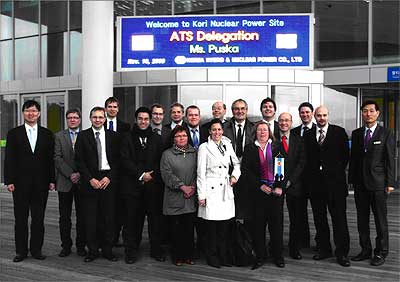
ATS group with its hosts during the visit to the Kori Nuclear Power Site.
The board of the Finnish Nuclear Society nominated Eero Patrakka, the former President of the waste management company Posiva, as head of the Old Generation (OG) section of ATS. The OG section’s main objective is to co-ordinate the activities of ATS members who have retired from the nuclear industry.
At the same time the activities of the other sections of ATS, namely Energy Channel and Young Generation (YG), continue to be very active. 43 new members joined ATS in 2009, increasing the total to 584.
http://www.euronuclear.org/e-news/e-news-27/myrrha.htm


The SCK•CEN MYRRHA project was first described in an article in ENS NEWS N° 21 (summer 2008). Since then an independent review of the project commissioned by the Belgian government has been carried out and the results made known. Such is the interest in this important project that ENS NEWS felt it necessary to give its readers an update. And here it is……
MYRRHA (for a more detailed analysis of the project go to: myrrha.sckcen.be/) is a multipurpose flexible fast spectrum irradiation facility with thermal islands, based on a sub-critical lead-bismuth cooled reactor, driven by a high power proton linear accelerator coupled to a spallation source. MYRRHA is intended to replace the BR2 material testing reactor in the early 2020s.
The Belgian government asked the OECD/NEA to perform an independent evaluation of the project. The results of the evaluation carried out by an international review team composed of André Versteegh (Chair, The Netherlands), Frank Carré (France), Jean-Marc Cavedon (Switzerland), Joachim Knebel (Germany), Paul Lisowski (USA), Toru Ogawa (Japan) and Derek Pooley (UK) are available on the NEA website at:
(www.nea.fr/html/science/reports/2009/nea6881-MYRRHA.pdf).
The expert review team came to the following conclusions.
MYRRHA is an innovative and exciting project and the facility would be unique in the world. It could play a role in the following contexts:
in decisions related to the transmutation of nuclear waste and the development of the associated technology
in the development of advanced nuclear reactors, especially lead-cooled reactors
as a fast neutron irradiation facility for materials and component testing for fission and fusion reactors
as a neutron irradiation facility for silicon crystal doping and the manufacturing of radioactive isotopes for medical and industrial sources
as a resource serving the needs of accelerator-based scientific applications (radioactive beams, proton therapy, proton-based isotope production, accelerator science,…)
The review team furthermore stated: "In summary, the overall estimated capital and operating costs for MYRRHA are reasonable and consistent with projects of a similar nature". The team acknowledges the excellent world-wide reputation of SCK•CEN and the important benefits that it has brought to Belgium. It, therefore, advises the government to give the go-ahead to the project and to provide funding for a further phase of work comprising, among other things of:
detailed design work, supported by R&D when necessary, in close collaboration with potential project managers and component suppliers
conversion of the existing general statements of interest from potential investors and users into firm commitments
The Belgian Government is expected to follow the recommendations by the expert review team and to announce that decision in the next few weeks.
ENS NEWS will keep readers up to date with further news of significance.
http://www.euronuclear.org/e-news/e-news-27/belgoprocess.htm

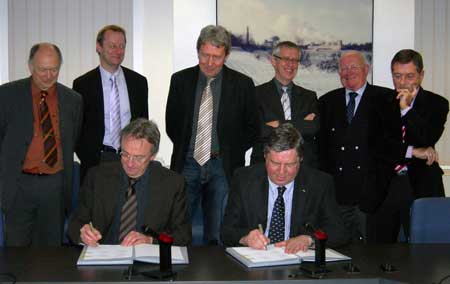
On 22 December 2009, SCK-CEN and Belgoprocess signed an agreement outlining systematic collaboration in several fields of research and, more specifically, in the field of nuclear technology development. In the following interview Eric van Walle, Director-General of SCK-CEN, and Rik Vanbrabant, Director of Strategy and Business Development at Belgoprocess, explain the origins and objectives of this agreement:
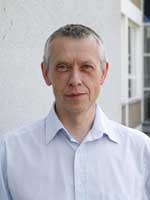 |
Rik Vanbrabant: Because we are neighbours and both active in the nuclear sector our companies have overlapping fields of work and we share common interests, even though our core businesses differ. Belgoprocess offers integrated nuclear waste management and decommissioning services, driven by safety and backed by 50 years of hands-on industrial experience. We have extensive knowledge of processing and the best technologies and facilities available for the processing, conditioning and storage of radioactive waste and for the dismantling of obsolete nuclear installations, including |
|---|
heavily alpha and/or beta/gamma-contaminated cells. Our 285 employees are experts in minimising the amount of radioactive waste produced and maximising the clearance of decontaminated material, whilst at the same time optimising operational costs.
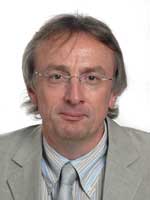 |
Eric van Walle: Based on more than 50 years experience, SCK-CEN advances the peaceful industrial and medical applications of nuclear science with the support of its 640 employees. Our statutory mission is to give priority to issues of societal concern such as the safety of nuclear installations, radiation protection, the safe treatment and disposal of nuclear waste and sustainable development. SCK-CEN’s activities are organised within three scientific areas: nuclear materials science, advanced nuclear systems and |
|---|
environment, health and safety. Research is made possible through the on-site availability of several large infrastructures: two high-performing nuclear research reactors, well-equipped nuclear and non-nuclear laboratories and an underground facility focussing on nuclear waste R&D. We spread our knowledge through participation in educational programmes, training courses and communications campaigns. Our know-how and facilities are also used to provide services to the nuclear industry and community, the medical sector and the government.
Rik Vanbrabant: Cooperation on a systematic basis creates opportunities for collaborative procurement actions for energy, consumer goods and services that may result in important cost savings. On top of that, the efficiency and the quality of our work will increase, which should have a positive impact on the services we provide to our external clients. Joining forces and combining our expertise will strengthen both SCK-CEN’s and Belgoprocess’ competitive position both nationally and internationally. We strive for collaboration in various domains such as business development, feasibility studies, routine research and other projects, the exchange of knowledge and techniques and in the training of personnel.
Eric van Walle: Because we are active in an innovative sector, it is important to update our personnel on the latest new techniques and technologies, and to improve their skills and overall well-being at work. We inform each other about our individual training programmes, which are set up to meet the specific needs of our employees. When there is a common interest in a certain topic we organise joint courses.
Furthermore, SCK-CEN offers courses on radiation protection, waste and disposal management, emergency planning, nuclear engineering and more. An overview of our education and training activities was presented in a previous edition ENS NEWS. We also work together with academic institutes and our experts lecture in courses such as those given at BNEN (the Belgian Nuclear higher Education Network) and radiation protection training courses for experts. The latter meets the legal requirements laid down by FANC/AFCN for the accreditation of the class I and II radiation protection experts. Employees of Belgoprocess participate in these courses regularly.
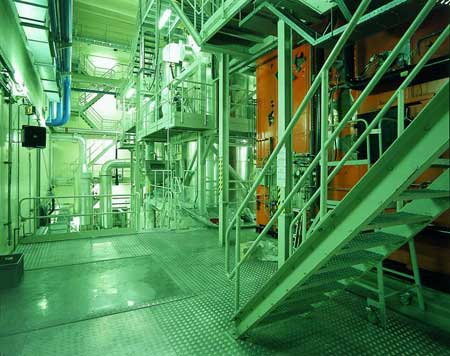
Rik Vanbrabant: For each of these themes our experts will meet regularly to exchange information and plan activities. Cooperation can vary from ad hoc collaboration on certain aspects of a technology or to providing services within a more structured partnership for a specific project or topic.
For example, with respect to developing a feasibility study on the application of plasma technology, SCK-CEN and Belgoprocess will take a closer look at all aspects of building, testing and operating a plasma oven, as well as on using plasma technology for processing various types of waste. In a first phase of this project we will evaluate the new application, possible waste streams, licensing and the costs of a demonstration run. We will also look at additional financing options.
Eric van Walle: Yes, we have already defined a number of cooperation initiatives. They range from information exchange on bitumen to joint initiatives for ENTRAP (European Network for Testing Facilities for Quality Checking of Radioactive Waste Packages). Our collaboration in this area will benefit the quality of the service that we offer our customers.
Similarly, for the joint consultative structure on nuclear liabilities, SCK-CEN and Belgoprocess will look into common challenges and solutions. Here too we have defined opportunities for collaboration, ranging from making use of each other’s infrastructure to exchanging knowledge and specific expertise required during decommissioning projects.
Rik Vanbrabant: Considering the good contacts that we have always maintained in the past we believe this agreement will prove to be the start of a fruitful cooperation that will benefit both organisations and will lead to strengthened national and international competitiveness.
ENS NEWS would like to thank Rik Vanbrabant and Eric van Walle for providing readers with this invaluable insight into the objectives and development of this cooperation agreement, and for providing the accompanying photos.

The new Visaginas NPP project continues to progress on schedule. The project’s development company, Visagino Atominė Elektrinė (www.vae.lt), VAE, is carrying out the preparatory work that is necessary in order to properly prepare for the construction of the new NPP. Some of the preparatory work, like the Environmental Impact Assessment, the Environmental Due Diligence of Construction Sites study, the Radioactive Waste Management Strategy document, a detailed plan of the land plots required for construction, etc. has already been completed. Other projects, like the assessment of construction sites against IAEA safety requirements, the transportation study etc., are at a very advanced stage and will be finalised in 2010.
To enable the construction of the new NPP it was recognized that Lithuania needs to attract investors capable of providing finance, the required nuclear operational expertise and considerable construction project management experience. For the purpose of attracting investors, an international advisory consortium, led by the investment bank N M Rothschild & Sons, was asked to prepare a business model and financing plan for the new Visaginas NPP project in Lithuania. This was presented in September 2009 and adopted by Lithuania.
The power market analysis performed by NERA set out to establish whether the potential evolution of the regional energy supply and demand scenario, the relative economic merits of different generation technologies and the projected forecast for long-term power prices based on a number of assumed scenarios are likely to create an environment that provides an incentive for commercial investment into new generation capacity. According to the findings of that analysis, when the existing power plants are shut down the entire Baltic region will encounter electricity supply shortages as of 2016. Existing and planned investments in power plants will not be able to meet the increased electricity demand. As such, in order to ensure a reliable electricity supply for the Baltic region and to reduce its dependence upon energy imports it is necessary and economically rational to invest in new generation capacity in the Baltic region and, in particular, in new nuclear generation. Additional renewable capacity will not provide the base load power supply required for the region, and additional fossil-fuel capacity will not allow Lithuania or the region to either enhance their security of supply situation or meet their green agenda. Nuclear investment allows Lithuania and the region to secure their energy supply and meet their commitments to low-carbon electricity generation.
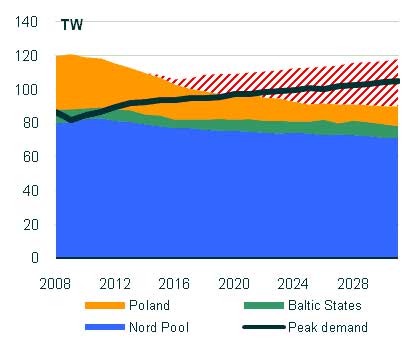
Picture 1. Interconnected projected region supply and demand
At the beginning of December 2009, Lithuania announced a call for investment in the new Visaginas NPP project. The purpose of this tender is to attract financially strong investors who have experience in the nuclear energy sector. The negotiations with regional partners (national utilities in neighbouring countries) and strategic Investors, as well as the signing of agreements with them for the further development of the new NPP project, will be finalised in 2010. The development timetable for the project aims to have the new NPP built in time to start generating electricity between 2018 and 2020.
There are two alternative construction sites that have been selected for the new NPP and both of them have been assessed against IAEA safety requirements. In addition, an environmental audit of both sites has been performed. The completion of the assessment of geotechnical and seismic factors at each of the construction sites is expected in 2010.
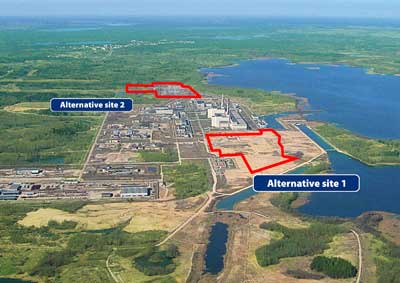
Picture 2. Alternative sites for the new Visaginas NPP.
Since the new NPP will be built near to the recently closed-down Ignalina NPP, some infrastructure from Ignalina NPP will be used by the new NPP, which will help to cut costs. The lake of Druksiai, which until recently had been cooling Ignalina NPP, will also be used for cooling of the new NPP. Comprehensive measurements of water temperature and meteorological conditions of the lake have been performed. Conclusions drawn from the analysis of the collected data will be needed to help with the selection of an optimum cooling system for the new power plant.
After thorough technical and market analysis, and a financial assessment of the project carried out by the advisory consortium in accordance with defined assumptions and scenarios, the development of a new NPP in Lithuania was considered to be commercially and economically viable. Based on a supportive regulatory and investment framework, such as the one that Lithuania is seeking to create, the new Visaginas NPP represents an attractive investment opportunity. The Visaginas NPP will also significantly enhance Lithuania’s and the region’s energy security and will contribute to the implementation of Lithuania’s National Energy Strategy.
By Giedré Krinicina, Visagino Atominė Elektrinė
http://www.euronuclear.org/e-news/e-news-27/ygn-reporter.htm


The 4th International Conference on Education and Training in Radiological Protection (ETRAP), organised by ENS in cooperation with the International Atomic Energy Agency (IAEA) and hosted by Portugal’s Instituto Technologico e Nuclear (ITN), was held from 8 - 12 November 2009 in the legendary capital of Portugal – Lisbon. This truly international event was attended by more than 120 participants from 26 countries. Experts from leading European and international organisations, universities, research institutes and industry representatives shared their experiences in delivering education and training in the field of radiological protection. However, the Young Generation was not represented in equal numbers at the forum.
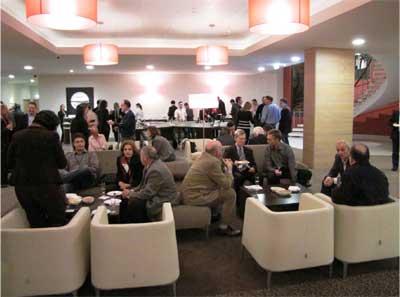
The first social event on the ETRAP 2009 agenda was the Welcome Cocktail. It took place on 7 November at the Novotel Lisboa Malhoa. In a friendly atmosphere fellow delegates met to talk about safety culture issues and to build foundations for future collaboration.
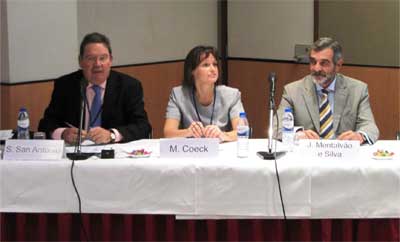
The ETRAP 2009 Official Opening session took place on Monday, 8 November. ENS Secretary General, Santiago San Antonio, chaired the session in which the President of INT Mr. J. Montavao e Silva and the Chairwoman of the ETRAP Programme Committee, Michelle Coeck, gave welcome addresses. As Mr. Montavao e Silva said, Portugal does not have nuclear power plants (only a small 1MW research reactor). Nevertheless, the vast and growing use of nuclear technology based equipment for medical and industrial applications implies a need for radiation protection activities provided by the ITN. Ms. Coeck expressed her satisfaction with the progress made since the previous ETRAP conference in 2005. She outlined the topics of common interest for the audience.
The ETRAP 2009 scientific programme was very dynamic, with 8 sessions for oral presentations and two poster sessions.
The first series of presentations was entitled “Setting the scene” and featured five keynote speakers from the European Commission (EC), the International Radiation Protection Agency (IRPA), the IAEA and the Organisation for Economic Co-operation and Development Nuclear Energy Agency (OECD/NEA), respectively. The first speaker Mr. S. Mundigl, EC Directorate-General for Energy and Transport, who introduced the revised European Basic Safety Standards (BSS) with a special focus on education and training requirements. The good news he gave is that the outcomes of the three workshops, organised within the EUTERP project, have been accepted.
Dr. A. Jouve (EC) then presented the EURATOM framework programme and Prof. E. Gallego (IRPA) introduced the IRPA strategic plan for the next 10 years. He stated that the IRPA will encourage activities to attract young people to the profession and young professionals to the IRPA congresses. Mr. J. Wheatley (IAEA) highlighted the IAEA’s achievements in the field and its future focus on the education and training in radiation protection. IAEA-run post-graduate education courses in radiation protection and safety of radiation sources are open to young professionals with a science/engineering degree. The OECD/NEA speaker Mr. U. Yoshimura raised the issue of the retention of skills and competence in radiation protection.
After lunch, the first poster session provoked intensive discussions.
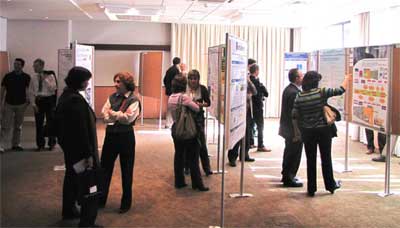
The following two sessions were about current developments in education and training in radiological protection and the developments in training delivery. Among those developments presented were radiation protection training programmes in Malaysia, the EU Joint Research Centre in Ispra (Italy) and Loviisa NPP in Finland. New distance learning systems were discussed. The developments in training delivery included the experiences gained from the PETRUS programme (education in the geological disposal of radioactive wastes), as well as examples from the Republic of Korea and Japan. The first day of ETRAP 2009 was then closed and the delegates had a free evening to explore the fascinating city of Lisbon.

Tuesday morning started with presentations on education and training networks, their achievements and the problems they have encountered. Very informative presentations were given on the ENETRAP project, the EUTERP platform, the role of the Federation of Independent Organisations of Medical Physics in Europe (EFOMP), the European Nuclear Education Network Association (ENEN) and Cooperation for Higher Education on Radiological and Nuclear Engineering (CHERNE). The role of small research reactors in education and training with regards to radiological protection was discussed at the end of the session. The most interesting for me was the presentation of Ms. Coeck. She underlined the specific objectives of the ENETRAP II as initiatives to attract early-stage radiation protection researchers on a European level. I learned that professional networks are involved in projects at different educational levels. Therefore, the possibilities for the young people to get involved are real and prospects for the young generation look quite good.
Another session was dedicated to approaches in sector specific training. The keynote presentation was given by Karl-Michael Schlicke, a representative of Siemens AG, which is a major supplier of medical x-ray equipment. The following five presentations covered nuclear power applications in the medical sector. This session had two parts with a break for the second Poster session.
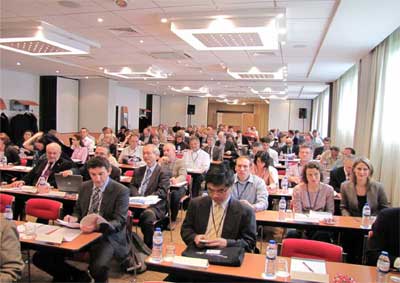
In the afternoon, talks on approaches in sector specific training continued. The urgent need to increase the radiation protection knowledge and awareness of the medical staff (physicians, nurses etc.) was highlighted. This long session finished after a presentation of a successful management model that took place in a Canadian nuclear installation. In short, sector-specific training has proved to be useful but “training is not everything”, as Ms. McQueen of Bruce Power said.
In the late afternoon session on broadening the prospects, education and training programmes offered by Idaho State University, the IAEA, the Belgian nuclear research centre (SCK•CEN) and B.A.D GmbH (Germany) were discussed. The next steps for improving radiation protection culture at a time of nuclear renaissance were discussed.
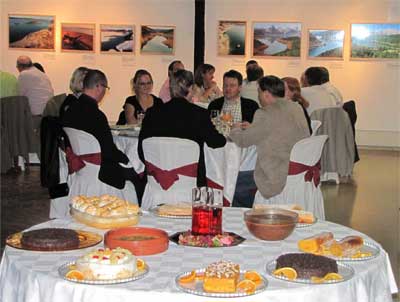
The ETRAP 2009 Conference Dinner took place at the Barbadinhos Steam Pump Station (built in 1880), at the Lisbon Water Museum. The delegates had a memorable evening in wonderful surroundings with a three course dinner and traditional Portuguese drinks. I asked Mr. Schlicke, one of the keynote speakers, for his opinion of the event. He said that it was a good idea to have dinner at a special place. “It provides very special atmosphere.” The food and wine were excellent and he really enjoyed the evening.
The last day of the scientific programme focused on two main topics: recent developments in the recognition and harmonisation of requirements and building the future.
In the first session, the United States’ Nuclear Regulatory Commission training programme was presented. Then the following topics were discussed: requirements for the recognition of radiation protection experts (RPE); radiation protection officers (RPO) and the establishment of European guidance for PRO training and the mechanisms for the evaluation of training materials and trainers. Also, several examples of radiological protection training courses were given, including some in Belarus, Slovenia and Portugal. The speakers agreed that the philosophy for promoting mutual recognition of radiation protection across Europe can be achieved only with the joint efforts of all concerned.
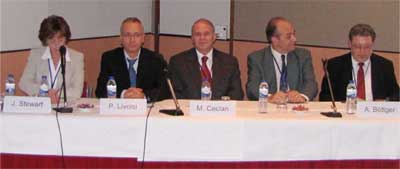
The last - but by no means least important - session was the one on building the future and attracting a new generation. This session was dedicated to European programmes in radiation protection. Dr. A. Bottger talked about the German experience in maintaining competence in radiation protection. He mentioned how a national programme facilitates the involvement of young scientists in Germany.
At the European level, three new European Masters Degree programmes in radioecology, radiation protection and advanced radiochemistry, have been developed. As Prof. Tamponnet (IRSN, France) said, the needs for such programmes have been identified following a stakeholder assessment and carried out within two European projects (EU-EURAC and EU-ENEN). A pilot MSc degree course in Radioecology, funded by the European Commission, will be run by the Norwegian University of Life Sciences. A “work in progress” programme - the ENETRAP II project (enetrap2.sckcen.be/) was presented by Prof. Ceclan, from Romania. The focus of his presentation was “the best means of attracting young people to the field of radiation protection”. The results will be communicated to other networks, such as EUTERP, ENS and ENS-YG. The last presentation in the scientific programme focuses on an ENETRAP outcome: The European Master’s degree in Radiation Protection “EMRP”. The speaker, Mr. Livolsi (CEA/INSTN, France), was delighted that important steps of the EMRP project have been accomplished, including a common programme framework. However, there are issues still to be discussed and sustainable funding to be obtained.
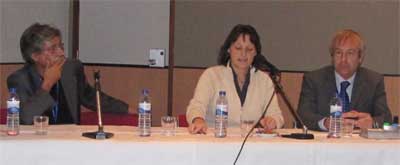
In the closing session, Mr. R. Paynter (Health Protection Agency – UK) summarised the achievements of the past four years. A considerable move forward has been made in the areas of clarification and harmonisation with the two projects: EUTERP and ENETRAP. The Qualified Expert concept has been reviewed and the definitions for Radiation Protection Expert and Radiation Protection Officer have been developed. Three workshops have been organised and all participants gave a commitment to a harmonised approach to radiation protection training. Ongoing international projects and other activities show that the level of international cooperation and commitment to achieving this goal is evolving. The Network structures can meet the needs for ongoing exchange of information on training activities and developments. A rationalisation of the existing networks is necessary to develop a common radiation protection and safety culture and apply a multidisciplinary approach to radiation protection training. These points will be included in a conference declaration, which will be issued later.
ETRAP 2009 ended with closing remarks from Ms. Coeck and Mr. A. Falcao (ITN). The conference organisers were congratulated for the good work done in making the event a success.
The Technical Visit to the ITN took place on Thursday, 12 November. We were introduced to the activities of the institute in the field of nuclear sciences and technologies, radiological protection and safety. I was impressed by the modern laboratories and the great number of young people working there. Also, we visited the 1 MW research reactor and we were allowed to take photos.
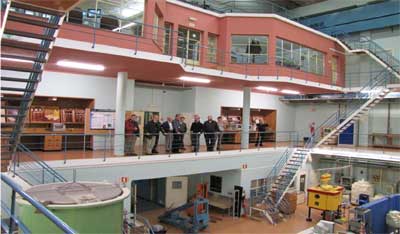
This was my first attendance at an ETRAP conference. My work as a Young Generation Network reporter was a great challenge for me. I think that the ETRAP 2009 was successful because many good presentations were given, very interesting posters were presented along with fruitful discussions and the participants had a good time.
Portuguese hospitality and perfect organisation were the main ingredients for its success. One of the major benefits of the ETRAP 2009 was networking. Unfortunately, not many young people attended the conference. This fact motivated me to collect useful information and share it with the ENS-YG community. During the coffee breaks and lunches I met many interesting people and recorded some of their opinions. Three important messages to the Young Generation can be found at the end of my report.Finally, I hope that more young people will attend the next ETRAP conference because together we will build the future.
I would like to thank the people who made my attendance at the ETRAP 2009 possible: Kirsten Epskamp and my PhD Supervisor Prof. Simon M. Pimblott, the ENS, The University of Manchester and BgNS. Special thanks to Ms. Coeck, Ms. McQueen, Mr. Mundigl and Mr. Schlicke for the interviews.
Pavlina I. Schmitz, MSc, AMRSC
School of Chemistry
The University of Manchester
United Kingdom
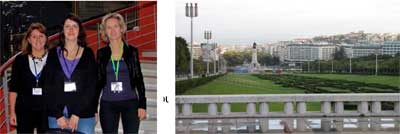
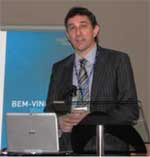 |
“Be well-trained and dedicated”. (Stefan Mundigl, European Commission, Directorate-General for Energy and Transport, Radiation Protection Unit) |
|---|
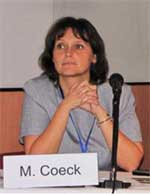 |
“Radiation protection is a major challenge in the industrial applications of ionising radiation. There is a trend of decreasing the number of experts in radiation protection due to various reasons. On the other hand, the current activities in the nuclear domain are expanding: the nuclear industry faces a so-called "renaissance". To ensure the safe use of ionising radiation is of utmost importance for all applications (nuclear industry, non-nuclear sector and medical). Currently, a |
|---|
significant part of the personnel retire and there are not enough new and young people to come. The challenge is to fill the gap and prepare for the future. One thing that will help is giving the young professionals a possibility to learn about radiation protection science, its fields of application, importance of the radiation protection tasks in different nuclear industries whose main aim is not radiation protection.
Important for young people is:
1. to broaden their view: understand the technical and scientific part, but also have a feeling for the philosophical and ethical context of the field they are working in: nuclear in general is difficult, also from social point of view.
2. to build confidence: important to understand and to be able to communicate on "the whole picture", benefits and disadvantages of the technique used, implications for safety of workers and environment.
Why study radiation protection? Because: 1. It is a fascinating science. 2. You can find a job in an industry where ionising radiation is used. This does not automatically mean the nuclear sector, it can also be the non-nuclear or medical sector. 3. You can have a responsibility towards society: you will be able to understand the benefits and the disadvantages of radiation, and you will be able to look over the safety of workers, environment and the public.”
(Michèle Coeck, SCK•CEN - Belgium)
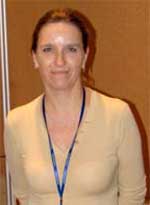 |
“It is as important not only to attract, but also to retain the young generation in radiation protection. 1. We should not just review what is current practice, but we need to talk to the young people in our field and ask them what we need to do and what they are looking for. 2. We need to understand the young generation, review studies on their age/motivation. They do not think or act like us – they are different. They will typically move jobs every few years |
|---|
3. We need to use new technologies to network and communicate with young people. We also need to introduce new technologies in the field of RP.
4. We need to expose young people to the depth of our subject area. We need to expose them to experts. They need to be at our conferences, they need to see the importance of the expert.
5. We need to let the young people themselves lead and design how we attract and retain them in our profession.”
(Maurine McQueen, Bruce Power – Canada)
"The Nuclear Sector in general and Radiation Protection in particular is a highly interesting field to work in work due to its technical and societal challenges. We from EUTERP are working on the recognition of your qualifications to facilitate free movement of workers troughout Europe."
( Folkert Draaisma, Coordinator EUTERP Platform, NRG - The Netherlands)
http://www.euronuclear.org/e-news/e-news-27/spanish-ygn.htm


Most people know that in April 1986 the world’s nuclear industry was shattered by the accident that occurred involving the N° 4 reactor at the Chernobyl Nuclear Power Plant (ChNPP) in Ukraine. Since then, every nuclear debate, every interview, every lecture that has taken place in a school or university has always included mention of Chernobyl. It was, therefore, obvious to us at the Spanish Young Generation Network (Jóvenes Nucleares, JJNN - a group of young nuclear professionals with a scientific background) that we needed to increase our awareness of what really happened, to speak on a sound factual basis about the accident and its consequences.
So, on November 20th, 24 JJNN members took part in a technical visit to the ChNPP.
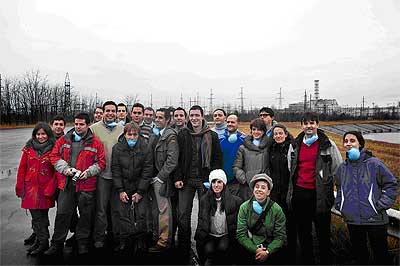
Spanish JJNN delegation close to Chernobyl reactors 5 & 6. Chernobyl reactors 3 & 4 in the background.
Having entered the 30 km exclusion zone, the Spanish Young Generation members were first brought to the Agency of Information, International Cooperation and Development (Chernobyl Interinform) located in the village of Chernobyl, around 15 kilometers from the plant. The agency belongs to the Ministry of Emergencies and Affairs relating to Population Protection from the Consequences of the Chernobyl catastrophe in Ukraine. In the building the guide provided the delegation with basic information about the accident and the areas that were affected by it.
Back in the bus that would bring the visitors to the nuclear power plant, it was possible to see, from one side of the road, the two unfinished cooling towers of Chernobyl 5 and 6, which were under construction when the accident took place. From the other side of the road could be observed the building devoted to the management of radioactive waste from decommissioning activities as well as the storage of 25.000 fuel elements.
When the delegation arrived at the plant, and after having gone through the required security controls, it was welcomed in the “mock-up room” by the Technical Director for Safety, Alexander Y. Novikov, and by the Technical Director for Operation, Sergey A. Kondratenko. The mock-up room contained three scale models: one of the entire nuclear power plant as it would have looked (with six operating units) had the accident not taken place, another one of a turbine building and the third one of a reactor cooling pump. Mr. Novikov, who was working there at the time of the accident, related the event. In front of the scale model of the turbine building, Mr. Kondratenko explained that reactor 2 was definitively shut down in 1991 due to a fire that broke out during an outage of the unit.
After this first general introduction to the functioning of the plant, the Technical Director brought the representatives of the Spanish Young Generation to the control room of reactor 1. In the control room the participants could observe the two instrumentation systems of the reactor core. The first one provided information about more than 1600 high-pressure valves. A specific colour code represented the different control rods. The second system enabled the analysis of the position of the different control rods using analogical indicators. Mr. Kondratenko explained that the plant worked on the basis of 12-hour shifts (8 to 8) with 4 operators and a head of section in each shift.
The second stop during the visit was the turbine hall. This building was different from the rest of turbine buildings that can be seen in other nuclear power plants around the world. Indeed, while in other plants each reactor can have its own turbine building or, at the most, two reactors share the same one, in Chernobyl, however, the turbine hall (a building of more than 500 meters long) housed the four reactors’ turbines.
Before going to the sarcophagus, the delegation paid a visit to Prypiat, the city which was built in 1970 to host the workers of the plant and their families. Between 45.000 and 50.000 people lived there. The city was evacuated more than 24 hours after the accident. The soviet authorities told the inhabitants that they had to take with them what they needed for only one week, as they were supposed to return to their homes a week later. They never did. Since 1986, the city has continuously been the victim of looting. |
|
Back at the plant the visitors arrived at the sarcophagus observation point, where reactor 4 can be seen. On this spot is also the monument that was built in memory of the people who helped to build the sarcophagus. The visit ended in the offices at the observation point, where a guide explained the actual state of unit 4. After the accident, a precarious and temporary structure, the so-called sarcophagus, was built in a hurry, without the time needed to develop a proper permanent design. This structure is just a kind of containment building to isolate the damaged reactor. The delegation was informed about the SIP (Shelter Implementation Plan), which has an estimated budget of around 1300 million US dollars, aiming at building a new structure covering and isolating the existing one. The project, once implemented, should enable the manipulation and further extraction of the radioactive materials still on site for further treatment and storage. The SIP, which has 5 main objectives, foresees the development of 22 different tasks which include, among others, mitigation of the risk of collapse and structural stabilization, dust and water management, fuel containing materials characterisation, etc.
During the walks around the perimeter of the plant and inside Prypiat, the effective dose equivalent was measured using a hand-dosimeter for estimating external exposure. The maximum readings were found in exposure situations where radionuclides were accumulated in the wild weeds (e.g. moss). However, in comparison with dose rate levels found in the city of Prypiat, it was observed that close to the moss levels were 10 times higher, and 100 times higher than those ones measured inside ChNNP.
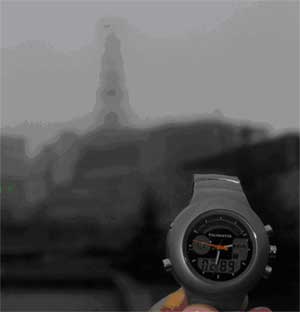
Picture 3: hand-dosimeter at the sarcophagus observation point.
Today, there are still around 3,000 people working in the Chernobyl area - plus the security forces surrounding the radiating 30 kilometers off-limits zone.
In the long-term, Chernobyl will remain a painful reminder of how important is to maintain higher safety standards and the responsibility that this technology brings with it. For all nuclear power professionals, who must always be committed to do their utmost to prevent any unexpected situations and be ready and prepared to act appropriately in the event of unforeseen circumstances: “good enough is not good enough”.
Thanks go to:
Spanish Nuclear Society Board.
Professor Emeritus Mr. Agustín Alonso.
Excellency Ambassador (View) Mr. José Luis Roselló.
Excellency Ambassador (Kiev) Mr. José Rodriguez Moyano.
Excellency Ambassador (View) Mr. Vododymyr Yelchenko
Mr. Alexander Y. Novikov: Technical Director for Safety (ChNNP)
Mr. Sergey A. Kondratenko: Technical Director for Operation (ChNNP)
Jóvenes Nucleares
Spanish Young Generation Network
http://www.euronuclear.org/e-news/e-news-27/cop-15.htm

The United Nations’ COP15 conference (Conference of the Parties to the United Nations’ Framework Convention on Climate Change (UNFCCC) took place in Copenhagen, Denmark from 7th to 18th December 2009. The objective was to establish the basis for a post-2012 agreement for a global CO2 emissions regulation. This required all signing parties to agree on individual targets for emission reductions.
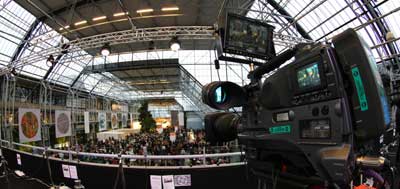
This ambitious goal raised huge interest amongst NGOs. Between 45000 and 50000 thousand participants from national delegations and NGOs, as well as observers, were registered to attend this major event. A discrepancy between the capacity of the conference hall and the demand for entry lead to access problems, especially during the second week of the conference. Only one third of the registered participants were finally granted access to the building. Several hours of queuing (frequently 6 to 9 hours) were necessary to get a precious entry badge.
The European Nuclear Society and the Young Generation Network represented the nuclear community, along with WNA/FORATOM and IAEA, by organising a side event entitled: Meeting young European engineers in an open discussion about nuclear and sustainability. WNA/FORATOM and the IAEA had booths located within the main hall. They hosted many visitors, who were given extensive documentation. Six YGN members from across Europe were part of the nuclear delegation: Neil Crewdson (UK-YGN, Sellafield), Arnaud Meert (Belgian Nuclear Society, Westinghouse), Steven Knol (Dutch YGN, NRG) Alexey Lokhov (French Nuclear Society YGN, CEA), Matthias Horvath (Swiss and Spanish-YGN, ENUSA) and Edouard Hourcade (Chairman of ENS-YGN, CEA). To prepare the ENS-YGN contribution to the event a 15-man team had been very active for more than six months prior to the conference.
Like in Poznan (COP14), hundreds of applications came from NGOs, keen to seize the few precious slots planned for official side events over the 2 week conference period. Once gain, the organisers had to go through a strict selection process and strongly encouraged the merging of side events. ENS-YGN merged with WNA and ended up organising the only side event dealing with nuclear energy.
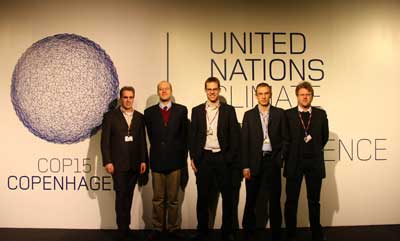
ENS-YGN gave the floor to three panellists:
Arnaud MEERT from the Belgian YGN, presented several assessments of CO2 emissions released from nuclear energy. He pointed out that fuel cycle steps have an important impact upon these figures which are, consequently, very country-specific.
Christian STOFFAES (CEPII) presented global scenarios comparing nuclear energy and bio fuels emissions targets.
Jan Horst KEPPLER (OECD/NEA) concluded the presentations with a broad view of the political and economical challenges of addressing climate change that face the nuclear community.
Alexey Lokhov and Edouard Hourcade moderated the debate.
Questions were raised by the audience about uranium resources and waste management. The living conditions of workers and of populations living close to nuclear facilities were also debated. Finally, many more informal discussions carried on between speakers and participants, whilst sharing Danish pastries.
Hundreds of pamphlets, which featured cartoons and facts and figures about nuclear energy - more specifically on safety and security, waste management and nuclear and CO2, - were distributed in order to address some of the typical concerns that people have about nuclear energy. These materials were widely distributed all over the conference and in particular the participating countries’ booths.
The event organized by ENS-YGN was considered a success by many of the participants. We offered them much-appreciated technical information and made clear what the contribution of nuclear energy as a mitigation option really is.
Our thanks go to ENS, NRG, Westinghouse, Sellafield Ltd, WNA and CEA for their great support for the event.
Edouard Hourcade
Chair ENS-YGN 2009-2011
http://www.euronuclear.org/e-news/e-news-27/nucnet-news.htm


4.01.2010 No. 7 / News in Brief
Belgium Should Fund Next Stage Of Myrrha Project, Says Report Radiation Applications
14 Jan (NucNet): The proposed Myrrha research reactor project in Belgium is an innovative project that could play a valuable role in both the management of radioactive waste and also in the development for the longer term of advanced nuclear fission and fusion reactors, an independent report has concluded.
The report, requested by the Belgian government and organised by the OECD’s Nuclear Energy Agency (NEA), concludes that Myrrha could help the European Union achieve the vision set out in its Sustainable Nuclear Energy Technology Platform. The platform identifies a set of competitive low-carbon energy technologies to be developed and deployed in Europe, with nuclear fission representing a key contribution.
The report recommends that the Belgian government funds the next phase of the project, but with “a major focus” on risk reduction so that full go-ahead could be given in two or three years’ time.
The Myrrha project began in 1998 at the Belgian Nuclear Research Centre (Centre d’Étude de l’Énergie Nucléaire, SCK-CEN) at Mol, northeast Belgium, and is aimed at the design, construction and operation of an accelerator-driven, lead-bismuth-cooled subcritical fast critical reactor.
In October 2009 SCK-CEN called on the Belgian government to clarify its position on the financing of the project, which requires an investment budget of 960 million euro (1.4 billion US dollars) over 12 years. The proposed Belgian contribution, which SCK-CEN says is “indispensable” to the reactor’s construction, is roughly 40 percent of the cost or about EUR 32 million a year over 12 years.
The remainder of the funds are to be provided by members of an international consortium of Myrrha partners, by the European Union and the European Investment Bank.
The report says Myrrha could be unique in demonstrating the principle of nuclear incineration, or transmutation, of minor actitudes and other long-lived radioactive waste.
The facility would also allow the EU and the international nuclear energy community to evaluate and develop some aspects of lead-cooled fast reactors, one of three fast reactor types being considered as part of the Generation IV programme for developing advanced fast reactor systems.
Myrrha could manufacture radioactive isotopes for medical applications, but would have to compete for this work with the Jules Horowitz reactor currently under construction in France and the proposed Pallas reactor at Petten in the Netherlands. Both these reactors would be better placed to produce commercially more attractive thermal neutron irradiation services, the report says.
The report adds that because the Myrrha project is so innovative “substantial risks remain”, including the possibility of a longer construction period and higher costs than anticipated.
Leo Sannen, manager of the Institute for Nuclear Materials Science at SCK-CEN told NucNet the report was "positive". He said Myrrha will allow for the shortening of the radiotoxicity of the waste as well as the security of radioisotope supply.
The report is available online (www.nea.fr).
14.01.2010 No. 7 / News in Brief
Slovenia Chooses Site For Radioactive Waste Repository Waste Management
14 Jan (NucNet): Slovenia has chosen a site near its only existing nuclear power plant for a low- and intermediate-level radioactive waste repository, with construction scheduled to begin in two to three years.
The country’s agency for radwaste management, ARAO (Agencija za radioaktivne odpadke), said today that Slovenia’s government passed a decree confirming the site on 30 December 2009 and the decree will come into force tomorrow, 15 January 2010.
The site, named Vrbina, is in the municipality of Krško, close to the Krško 666-megawatt pressurised water reactor unit, which has been in commercial operation since 1983.
ARAO said the repository’s completion will place Slovenia among the countries that have provided a long-term solution for the disposal of radioactive waste.
Two silos will have the capacity for as much as 9,400 cubic metres of low- and intermediate-level radioactive waste, which comprises half of the radioactive waste generated by the Krško nuclear unit during its operation and decommissioning. The site will also be used for storage of all institutional waste generated in Slovenia.
Site capacity can be increased should there be an expansion of the Slovenian nuclear programme or an agreement between Slovenia and Croatia, which owns a 50-percent share in Krško.
After an initial failure in early 1990s, Slovenia started the new site selection process in 2004. The Ionising Radiation Protection and Nuclear Safety Act stipulated that the location must be selected by 2008 and that the repository must start operating on a regular basis by the end of 2013.
20.01.2010 No. 10 / News in Brief
Nuclear Energy Production Breaks Records In Finland Plant Operation
20 Jan (NucNet): Nuclear energy production in Finland in 2009 was the highest ever, despite the fact that electricity production fell seven percent because of the global economic crisis.
The Finnish Energy Industries trade association said today that nuclear energy production was 22.6 terawatt hours in 2009 and accounted for almost 28 percent of electricity consumed.
Combined heat and power generation covered almost 30 percent of electricity consumption, hydropower 15 percent, and coal and other condensing power more than 11 percent. The share of wind power was 0.3 percent.
Finnish Energy Industries said that towards the end of 2009 power consumption again turned to growth, an indication that the worst of the recession is over.
“Nevertheless, the slump left a definite mark on 2009, and electricity consumption fell by seven percent,” a statement said.
It was also a record year for electricity imports, which accounted for 15.3 percent of energy consumption. The most expensive days for power saw prices of 1,000 euro (about 1,400 US dollars) per MWh. Finnish Energy Industries managing director Juha Naukkarinen said this shows the need for new generating capacity.
Finland has four nuclear units in commercial operation and one, Olkiluoto-3, under construction. OL-3, a 1,600-megawatt European pressurised water reactor unit, is scheduled for completion in June 2012.
Three environmental impact assessment procedures are under way that could lead to construction of a sixth unit
21.01.2010 No. 11 / News in Brief
Refuelling Outages Lead To Slight Fall In Spain’s Nuclear Production
21 Jan (NucNet): Spain’s eight nuclear units produced 17.55 percent of the country’s electricity in 2009, down from 18.29 percent in 2008, Spanish industry group Foro Nuclear said yesterday.
The decrease was due to nearly all of Spain's nuclear units having refueling outages during 2009, Foro Nuclear said. Some units had extended outages because of maintenance or upgrade work.
In 2009, nuclear’s share of Spain’s installed generating capacity was about 8.14 percent.
22.01.2010 No. 13 / News in Brief
Urenco Worker Under Observation After UF6 Leak At German Facility
22 Jan (NucNet): An employee at Urenco’s Gronau enrichment plant in Germany has been admitted to hospital as a precaution after a few grams of uranium hexafluoride (UF6) leaked from a container in a preparation facility.
Urenco said today that the incident occurred at 14:32 local time yesterday. The worker became contaminated as a result of the leak and was admitted to Münster university hospital for 24 hours’ observation.
The incident posed no risk to the local population because the affected air passed through filters. Readings from the plant’s chimney show emissions remain well below regulatory limits, the company said.
UF6 chemically decays when it comes into contact with humid conditions and releases highly aggressive fluoric acid.
According to Urenco, the hospital has reported that the worker concerned was feeling better today and “in good shape considering the circumstances”.
Urenco said appropriate authorities had been told and it is determining the cause of the incident.
Gronau is close to the Dutch-German border in North-Rhine-Westphalia, some 40 kilometres from Urenco’s Dutch enrichment plant. Uranium is enriched in centrifuge cascades to the U235 assays required by nuclear power plants.
Urenco’s shares are held one-third by the UK government, one-third by the Dutch government and one-third by the German utilities RWE AG and E.ON AG.
http://www.euronuclear.org/e-news/e-news-27/other-conferences.htm

![]()
2 March 2010
Radisson Blu Royal Hotel, Brussels
Belgian Nuclear Society
more
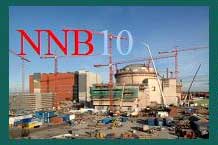
2 - 3 March 2010
London, United Kingdom
Nuclear Institute
E-mail: r.hayman@nuclearinst.com
more
All European Nuclear Society members receive a 10% discount when registering for this event.

7 May 2010
Brussels, Belgium
SCK.CEN, ISI IRE, IBA, EITA and BNS
Prof. Em. Michel Giot
michel.giot@sckcen.be
more
11 - 12 May 2010
Brussels, Belgium
Foratom
Tel: +32 2 502 45 95
Email: info@ena2010.org
more

16 - 20 May 2010
Dubrovnik, Croatia
Croatian Nuclear Society
Unska 3
10000 Zagreb
Croatia
Tel: + 385 1 6129 627
E-mail: hnd@cro-nuclear.hr
more
12-18 July 2010
Cape Town, South Africa

29 August - 2 September 2010
at the Shilo Inn Convention Center in Idaho Falls, Idaho, USA
Teri Ehresman
Assistant General Chair
Tel: (208) 526-7785
Fax: (208) 526-2930
Email: teri.ehresman@inl.gov
more

26 to 29 September 2010
Orlando, Florida, USA
American Nuclear Society
email: fuel@fuel.ans.org
more
26 to 30 September 2010
Avignon, France
Patricia Hamel-Bloch
SFEN
5 rue des Morillons
F-75015 PARIS
Tel: 33.1.53.58.32.12
Fax: 33.1.53.58.32.11
Email: phamel-bloch@sfen.fr
more
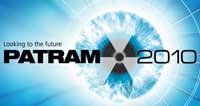
3 - 8 October 2010
London, United Kingdom
Department for Transport of the United Kingdom
more

17 - 20 October 2010
Hitotsubashi Memorial Hall, Tokyo, Japan
Japan Atomic Energy Agency
more

9th International Conference on Tritium Science and Technology
24 - 29 October 2010
Nara, Japan
National Instiute for Fusion Science Safety and Environmental Research
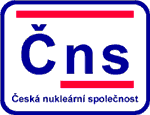
1 - 3 November 2010
Prague, Czech Republik
Czech Nuclear Society
more

4 - 9 September 2011
Nagoya, Japan
Atomic Energy Society of Japan
email: global2011@jaea.go.jp
more
http://www.euronuclear.org/e-news/e-news-27/Member-Societies.htm

Austrian
Nuclear Society |
Belgian
Nuclear Society |
Bulgarian
Nuclear Society |
Croatian
Nuclear Society |
Czech Nuclear Society |
Finnish
Nuclear Society |
French
Nuclear Energy Society (SFEN) |
German
Nuclear Society (KTG) |
Hungarian
Nuclear Society |
The
Israel Nuclear Society |
Italian
Nuclear Association |
Lithuanian
Nuclear Energy Association |
Netherlands Nuclear Society |
The Nuclear Institute |
Nuclear
Society of Russia |
Nuclear
Society of Serbia |
Nuclear
Society of Slovenia |
Polish
Nuclear Society |
Romanian
Nuclear Energy Association (AREN) |
Slovak
Nuclear Society |
Spanish
Nuclear Society |
Swedish
Nuclear Society |
Swiss
Nuclear Society |
http://www.euronuclear.org/e-news/e-news-27/Corporate-Members.htm

Links to ENS Corporate Members
|
http://www.euronuclear.org/e-news/e-news-27/editorial.htm
Mark O’Donovan, Editor-in-Chief
Contributors to this Issue:
Boryana Atanasova (BgNS)
Mathieu Carey (NucNet)
Kirsten Epskamp (ENS)
Edouard Hourcade (Chair ENS-YGN)
Giedré Krinicina (Visagino Atominė Elektrinė)
Keith Miller, (NNL)
Pavlina I. Schmitz (British YG)
Vladimir Slugen (ENS)
Francis Sorin (SFEN)
Andrew Teller (Areva)
Rik Vanbrabant (Belgoprocess)
Eric van Walle (SCK-CEN)
Realisation:
Marion Brünglinghaus
Rue Belliard 65, BE-1040 Brussels
Phone +32 2 505 30 50 - Fax: +32 2 502 39 02
E-mail: info@euronuclear.org - http://www.euronuclear.org
The ENS News is a quarterly publication, in electronic
form only.
Copyright notice ©2010 European Nuclear Society.
Reproduction is authorised provided that the ENS News is acknowledged as the
source – except where otherwise stated.
![]()
© European Nuclear Society, 2010